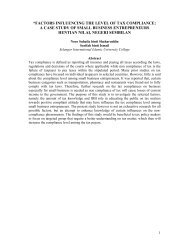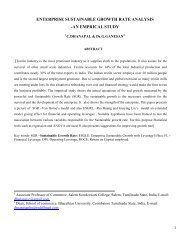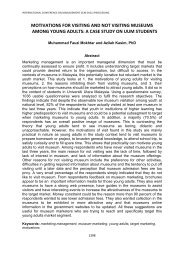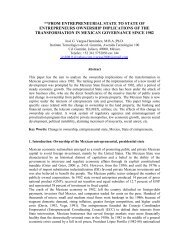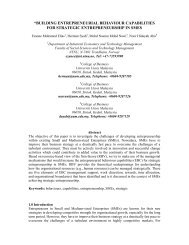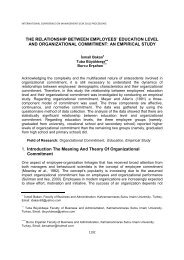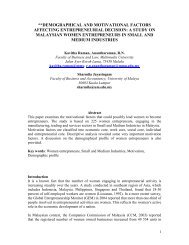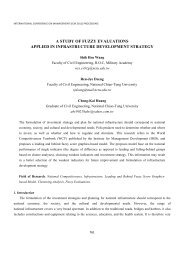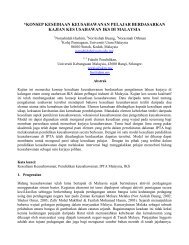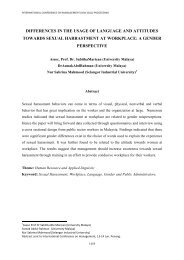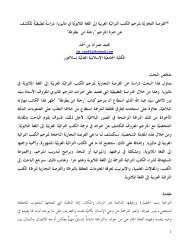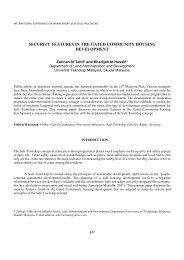operational analysis of a select spinning mill - International ...
operational analysis of a select spinning mill - International ...
operational analysis of a select spinning mill - International ...
You also want an ePaper? Increase the reach of your titles
YUMPU automatically turns print PDFs into web optimized ePapers that Google loves.
3. OBJECTIVES OF STUDY<br />
The following may be taken as the objectives <strong>of</strong> the study:<br />
3.1. To find the relationship between production and raw material consumption and yield.<br />
3.2. To find the association between Spinning production and costs.<br />
3.3. To predict the <strong>spinning</strong> production using Cobb Douglas production function.<br />
3.4. To <strong>of</strong>fer plausible suggestions for improvement in cost and efficiency.<br />
4. REVIEW OF LITERATURE<br />
1 Imran Sharif Chaudhry et al (2009) have made study on “Factors Affecting Cotton<br />
Production in Pakistan: Empirical Evidence from Multan District”. They examined the factors<br />
affecting cotton production. In that study Cobb-Douglas Production Function was used to assess<br />
the effects <strong>of</strong> various inputs like cultivation, seed and sowing, irrigation, fertilizer, plant<br />
production and labour cost on yield.<br />
2 Moosup Jung, et al (2008) made a study on” Total Factor Productivity <strong>of</strong> Korean Firms<br />
and Catching up with the Japanese firms “.They measured and compared the TFP <strong>of</strong> both<br />
Korean and Japanese listed firms <strong>of</strong> 1984 to 2004.They used the Chain Linked Index Number<br />
method developed by Good et. al.(1999). They found that the average TFP <strong>of</strong> Korean firms grew<br />
about 44.1% between 1984 and 2005, with 2.1% annual growth rates. Industry was observed to<br />
be outstanding.<br />
3 Danish A. Hashim made research on” Cost and Productivity in Indian Textiles” for<br />
Indian Council for Research on <strong>International</strong> Economic Relations. His observations and findings<br />
are: There is an inverse relationship between the unit cost and productivity: Industry and States,<br />
which witnessed higher productivity (growth) experienced lower unit cost (growth) and vice -<br />
versa. Better capacity utilization, reductions in Nominal Rate <strong>of</strong> Protection and increased<br />
availability <strong>of</strong> electricity are found to be favourably affecting the productivity in all the three<br />
industries.<br />
___________________________________<br />
1 Imran Sharif Chaudhry, Muhammad Bashir Khan ( Bahauddin Zakariya University Multan,Pakistan )<br />
and Mumtaz Anwar(University <strong>of</strong> the Punjab, Lahore, Pakistan)-“ Factors Affecting Cotton Production<br />
in Pakistan: Empirical Evidence from Multan District”- Journal <strong>of</strong> Quality and Technology Management,<br />
Volume V, Issue I1, Dec, 2009, pg. 91-100.<br />
2 Moosup Jung, Keun Lee( School <strong>of</strong> Economics, Seoul National University korea) and Kyoji Fukao<br />
(Hitoshubashi University, Japan )- Total Factor Productivity <strong>of</strong> Korean Firms and Catching up with the<br />
Japanese firms- Seoul Journal <strong>of</strong> Economics, vol 20,no 1, March 2008.<br />
Gokhale 1992 in Cotton Mill Sector', Productivity, January- March.<br />
3 Danish A. Hashim (2004)- cost and productivity in Indian Textiles- Indian Council For Research On<br />
<strong>International</strong> Economic Relations. Multan District” Journal <strong>of</strong> Quality and Technology Management,<br />
Volume V, Issue I1, Dec, 2009, pg. 91-100<br />
3




